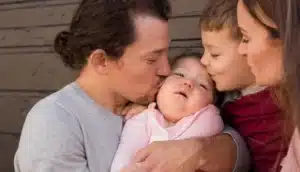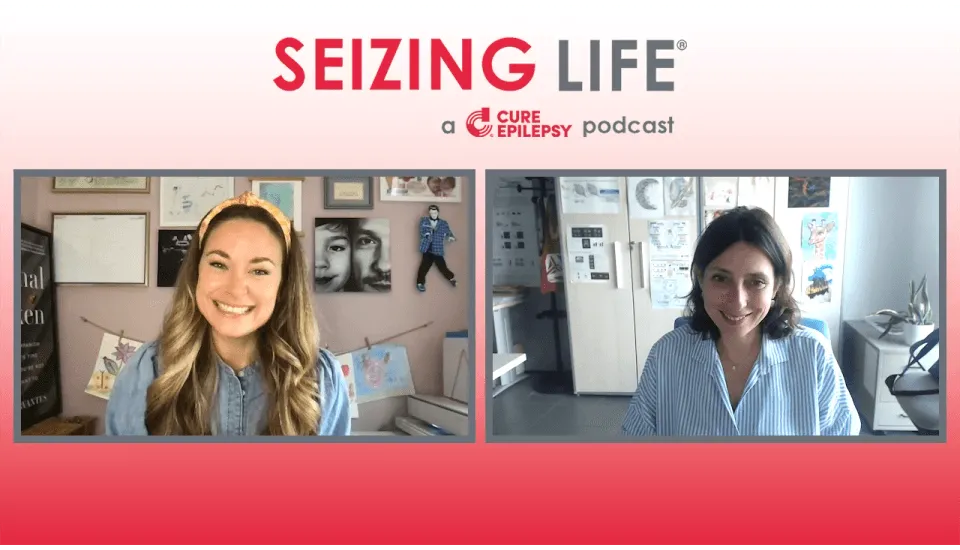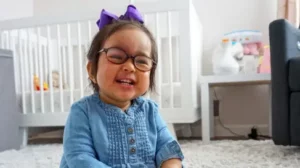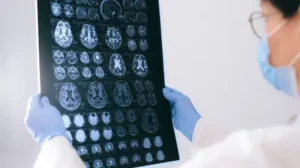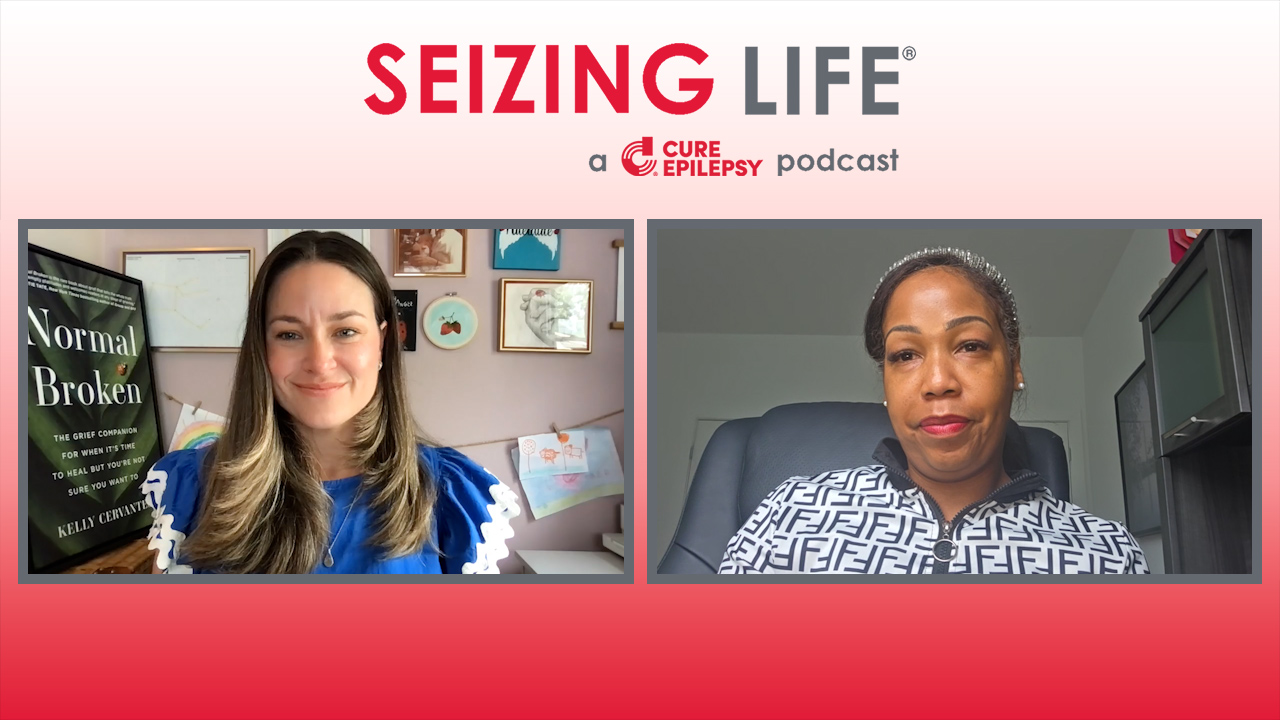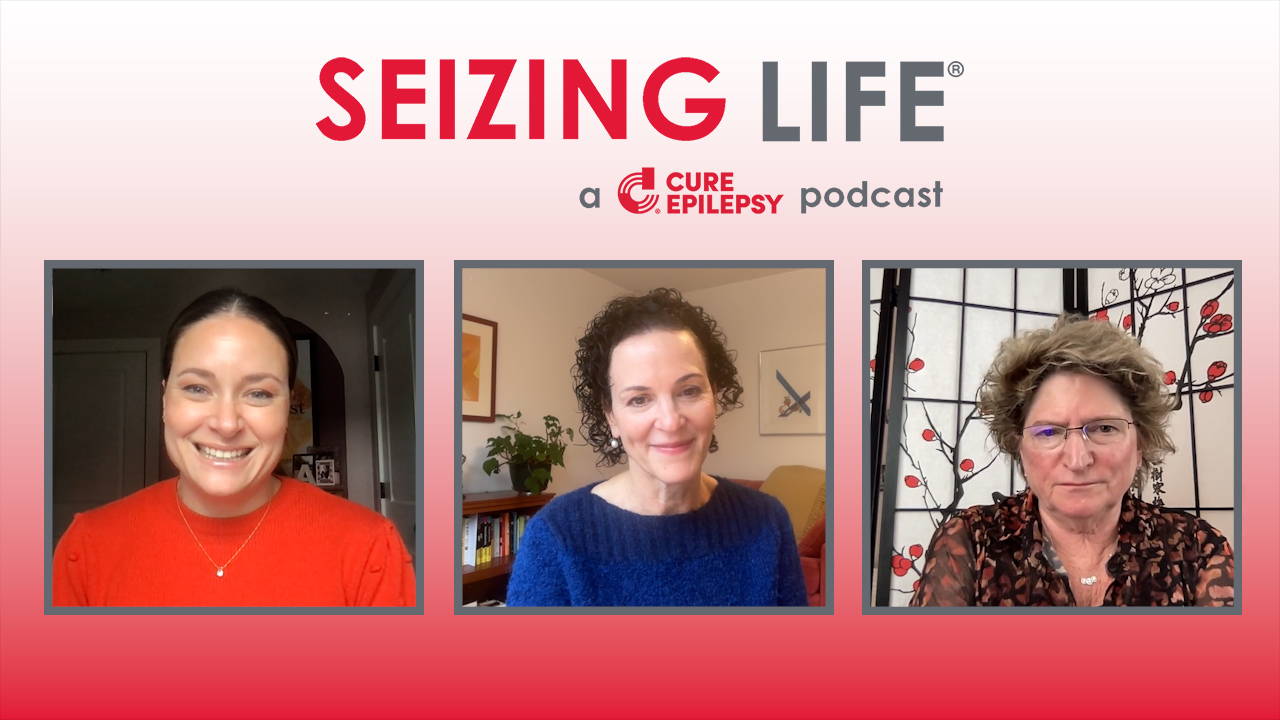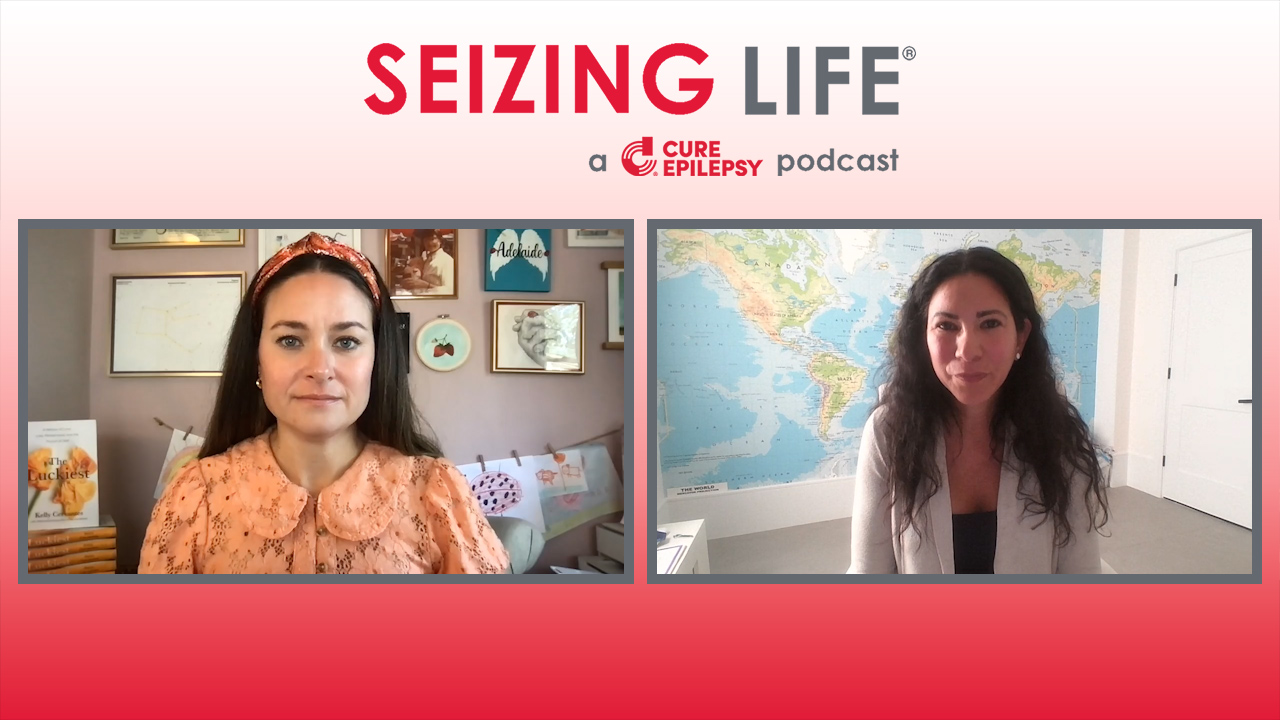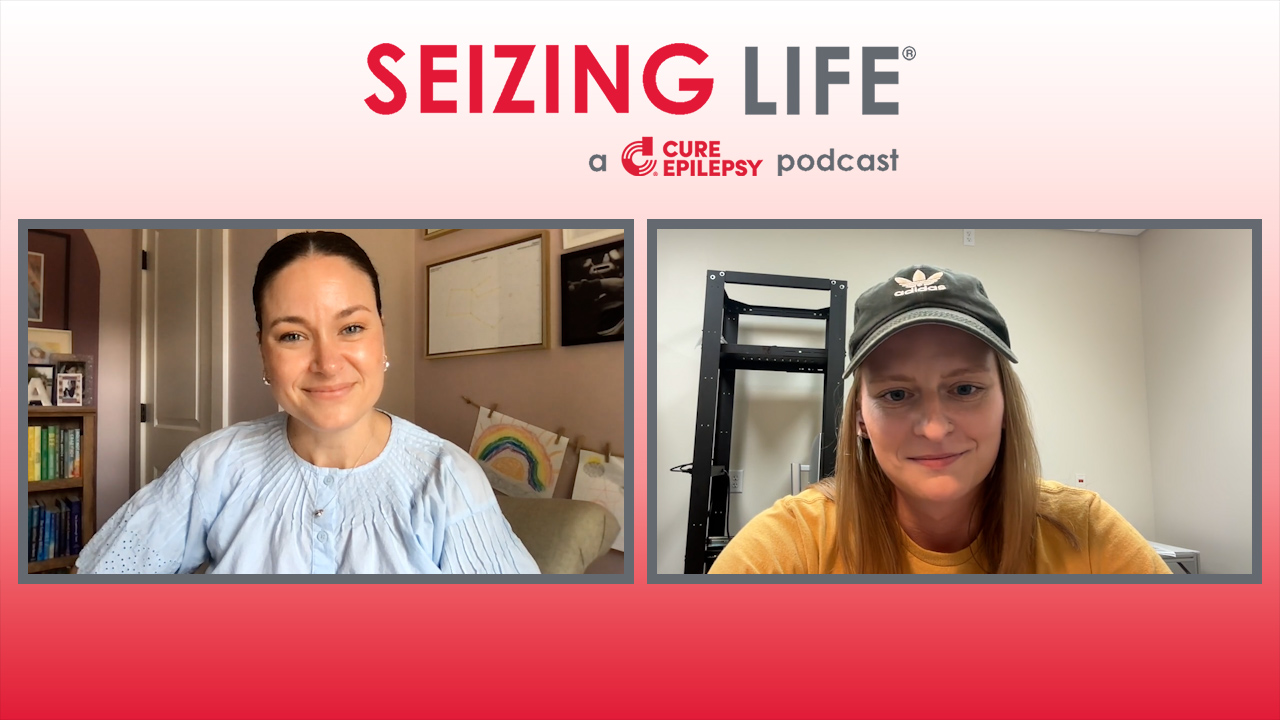A Family’s Journey with Panayiotopoulos Syndrome
Episode Overview
This month on Seizing Life®, journalist, television executive, and mother Scarlette Whyte joins us to share her family’s experience with Panayiotopoulos Syndrome, a type of early childhood epilepsy with which two of her three children have been diagnosed.
Scarlette Whyte’s son Don was visiting his grandparents when he experienced his first seizure at the age of four. Subsequent tests resulted in a diagnosis of Panayiotopoulos Syndrome, a form of childhood epilepsy that usually occurs between the ages of three and six years old. Seizures resulting from Panayiotopoulos Syndrome are often accompanied by vomiting, loss of control of bodily fluids including urination, and secretion of mucousy liquid from the nose and mouth.
Scarlette shares her own shock and confusion at the diagnosis, and details Don’s treatment journey including a stressful breakthrough seizure that occurred on an international flight. She explains why her initial choice to keep the diagnosis from teachers and coaches eventually transformed into sharing the diagnosis publicly and becoming an advocate for epilepsy awareness.
Scarlette also outlines how her family’s initial belief that Don’s epilepsy is not genetic changed when her daughter was also diagnosed at age four with Panayiotopoulos Syndrome, and how that fosters a sense of anxiety about her third child developing the same syndrome. Finally, Scarlette discusses the challenges of parenting a child with epilepsy as they get older and begin to express their own emotions about their condition.
Episode Transcript
Kelly Cervantes:
Hi, I’m Kelly Cervantes and this is Seizing Life, a monthly podcast produced by CURE Epilepsy.
Today I’m happy to welcome Scarlette Whyte to the podcast. Scarlette has worked in television news for nearly 20 years as a journalist and television producer, and is currently an executive at CNN. She is also a wife and mother to three children, two of whom have been diagnosed with a form of epilepsy called Panayiotopoulos syndrome. Scarlette is here today to tell us about Panayiotopoulos syndrome and share her family’s epilepsy journey.
Scarlette, thank you so much for joining us today. I am excited to have this conversation, but to start, can you just tell us a little bit about your self, your background, and your family?
Scarlette Whyte:
Okay. Well, thank you for having me today, Kelly. I sincerely appreciate the invite. So my name is Scarlette Whyte. I have been married to my husband, Don for 18 years. We have three amazing kids who are ten, eight and four, and I work for CNN as well as TNT Sports. So I am the head of Inclusion Partnerships for both CNN and TNT Sports, and I have been in the news business for nearly two decades. I love being a journalist and having a front row seat to history has been the ride and the honor of a lifetime. And I’m a basketball mom, a ballet mom, and now a soccer mom. So all three of them are in sports now, which means I don’t get any sleep between work and kids.
Kelly Cervantes:
You are a professional chauffeur, as my mother likes to remind me when my brother and I were kids, always busy and then epilepsy enters your life and life becomes a little more chaotic. Tell us about how epilepsy first entered your family?
Scarlette Whyte:
Oh my goodness. So epilepsy came. It was so unexpected. There was nothing that could have prepared me for this journey that we’ve been on for five years now.
So my oldest got diagnosed with epilepsy literally two days before the world shut down in March of 2020. And even when we went to Children’s Hospital, it was like, should we wear masks? Should we not? It was literally right as the world was shutting down when I was being gut punched with the diagnosis that I never saw coming, never expected. So long story short, my kids were two — I only had two at that time. It was before I had my third. They were in Michigan visiting my parents for the weekend. And I’ll never forget, it was a Sunday afternoon and my dad called me and he said, ‘we’re at the hospital, we had to come here via ambulance, they think he had a seizure in the grocery store parking lot.’.
And I was like, what – what? My oldest, Don the III, who we affectionately call Dewster (phonetic) for his initials, DEW. And so I was just frozen. I couldn’t believe what my dad was telling me, one, that my child just had to get taken to a hospital in an ambulance. And two, that the emergency room doctor thought it was a seizure. And then my dad said, ‘I will FaceTime you as soon as the doctor comes back in.’ And they were in the ER at this point. So when the doctor came into the room and he was explaining the signs and symptoms, he was like, obviously he needs to stay in the hospital for observation. And then once you get him back to Washington DC, he needs to be tested. You need to get a formal diagnosis. And all the things he was telling me, it was just like I couldn’t absorb any of it.
And so my uncle is a doctor, and so I asked the emergency room doctor, I said, ‘do you mind if my dad FaceTimes my uncle in?’ And I said, ‘because I am not understanding anything you’re saying right now.’ I couldn’t hear anything past – we think this is a seizure and he may have epilepsy. I couldn’t absorb anything beyond that. So once he stayed in the hospital in Michigan, he was cleared. My parents flew both of my kids home at that time and we went to Children’s Hospital and that is the day our journey officially began. And it was a shock then, and I’m still kind of in shock five years later. Long story short.
Kelly Cervantes:
Yeah. It had to have been so unbelievably challenging to be faced with this very unexpected news and to be so far away and to not be able to be there in person and to see your son. I can only imagine how scary that was. So you get your son back, he’s at Children’s Hospital and at that point they do the tests and is that when the doctor’s diagnosed him with epilepsy? And tell us how the doctors explained that to you.
Scarlette Whyte:
Okay, so when we did the initial round of testing, they told me everything that was going to have to happen from the, I believe the EEG. They had to hook up monitors to his chest, to his head. And they told me, they said, ‘you have to bring him in sleep-deprived.’ And I was just like, okay, what does that mean? And so they said, ‘let him stay up really — really late and wake him up really — really early.’ And so we got the earliest appointment that we could.
So we get there and they’re hooking him up to everything. And so the neurologist came in and said, ‘we should be able to get some answers today and kind of nail things down.’ We did the initial testing and before we left, it was what they suspected — that it was epilepsy, that he definitely had a seizure when he was in Michigan.
And what was more shocking for me was how they were able to explain it in a step further was that the seizures were on the back left side of his brain. And they said that was typical kind of in boys, and it was this term I had never heard of before called Panayiotopoulos syndrome. And I’m like, wait a minute, what? So they said, yeah, seizures are different. They show up in different people differently and there’s different kinds of seizures. And I always was of the mind that seizures were the textbook drop to the floor, convulsing, foaming at the mouth or whatever. And for Panayiotopoulos syndrome, there’s what they call silent seizures, that it happens in their sleep. And yes, they do lose bodily fluids, they lose them, but he doesn’t convulse.
And so my husband looked at me, he said, ‘you know what Scarlette?’ he said, ‘when he was in Michigan, he was like, now looking back, I don’t think that that was his first seizure.’
And so he reminded me of a time a few months before that, which was in December 2019, and my son was in a deep sleep and he just — he had mucus pouring out of his mouth. He vomited and then he wet his pants when he woke up and he had a slight headache and he had a slight temp. And so we were just like, okay, he’s having some weird childhood fever.
And I called my uncle who is a doctor. He was like, I think it’s just a fever — follow up with your pediatrician in the morning. And my uncle had kind of warned me then and again, it went in one ear and out the other, he was like, if this keeps happening, this could be some kind of a seizure. But again, I completely blow that off because it’s like this doesn’t run in our family. That doesn’t apply to me. And so then fast-forward from December 2019 to March 2020 and we get to Children’s. And so when my husband described to the neurologist exactly the same thing, and so the neurologist said, ‘yeah, he may have had one back in December and you just didn’t know what it was.’ And I said, again, I’m thinking seizures are convulsing on the floor, shaking and he doesn’t do any of that.
Kelly Cervantes:
Yeah. It’s — It’s wild to me now being in this epilepsy world for the 10 years or so that I have been — that we really — I mean I didn’t know either. I thought that seizures were all convulsions and that this isn’t more wider known that seizures can look so different because it is all these different types of syndromes because there’s so many different types of seizures because of where it can occur in the brain or why they’re occurring or all of these different things. It seems to be this huge gap in just general knowledge about epilepsy and seizures in general. So you get this diagnosis of this particular epilepsy syndrome, and did they start him on medication and if so, how did that work?
Scarlette Whyte:
Oh gosh, yes. So the first medication that he started on, it was absolutely terrible. He went from, the side effects were just terrible. He went from being a very vibrant, happy-go-lucky boy to being very quiet, to crying over things he wouldn’t normally cry over. He became very emotional and sensitive to the point where I told the neurologist and my uncle, I said, ‘he’s turning into a different kid. I can’t — I can’t have this.’ And so that’s when we started Trileptal. And so while it was definitely some side effects, he was still the same kid. Like it didn’t — I felt like the first medication completely changed his little personality and I was just like, absolutely not. He’s so vibrant. I don’t want him in a corner quiet and secluded. Like again, his little personality did a complete 180 for the few weeks that he was on the initial medication.
Kelly Cervantes:
It’s like throwing darts at a board trying to find the medication that works or the medication that the side effects are the most tolerable.
Brandon:
Hi, this is Brandon from CURE Epilepsy. Did you know that 30% of those diagnosed with epilepsy do not respond to current medications? That is why for 25 years CURE Epilepsy has been committed to inspiring hope and delivering impact by funding patient-focused research to find a cure for epilepsy, learn more about our mission and our research by visiting CURE epilepsy.org. Now back to Seizing life.
Kelly Cervantes:
So you find Trileptal and that seems to work for the seizures and have more minimal side effects. And has he had any additional seizures since then?
Scarlette Whyte:
So unfortunately he has. So we were on Trileptal for a few years and the neurologist felt like he was doing well. And then fast-forward to 2023 when I hosted an event with CURE Epilepsy here at my house, and I met Dr. Schreiber, who is an amazing neurologist at Children’s Hospital, and I told him that we had been there under a different doctor’s care and then we moved over to Dr. Schreiber. And so he did so well to the point where Dr. Schreiber said, ‘okay, I think you can take the medication down to once a day.’ So he did well on that and then he said, ‘okay, I think we can hold off and take medicine as needed.’ So we went almost a year without a seizure. And then he had a seizure in December 2023, and then he had another one in December of 2024.
And that one was probably the most nerve wracking for me as a mom because it happened on an airplane. We were coming back from the Caribbean, we were over international waters, so having to do an emergency landing in the ocean was not an option. And so the pilot came out — it was — it was just –it was bad. This was probably the worst in many ways because we were midair when it happened. And usually when my son has one, he usually snaps out of it right away, like, ‘oh, what are we eating for dinner, can we do this?’ He’s just — He goes back to normal. And this one, it took him a few days to get back to normal. And so I was just going through the checklist in my mind of after your kid has a seizure, which is a checklist I had to provide to his school, if they are coherent and they can speak to you and they can answer situational questions, you don’t need to call 911. You should definitely follow up with their neurologist that day or the next day. But if they’re not responsive or they’re just kind of lethargic and out of it, you may need to.
So the stewardess went to get the pilot and he came out and he was like, ‘mom, what do you want me to do?’ He was like, ‘we can try to make it to Florida or Texas or something and land.’ But my son was responsive. He was not as chatty, but he still knew his name. He knew what grade he was in, he knew what my husband’s name was. I was like, where did we just come back from? Who did we go on vacation with? And so because he was able to answer all those questions, I told the pilot that I was fine with us going to the destination because I did not want to interrupt the flight for all those other passengers. And everybody was, they were so sweet and so understanding from the passengers on board to the stewardess, the pilot. And so when we landed, the pilot came on and said, we have a passenger on here that had a medical emergency, please let this family exit before everybody else starts to deplane.
And so as soon as we got there, they had the gurney for him. A Delta Air Lines representative came out, an airport official came out because a medical emergency happened on their watch so they had to do all the reporting and things. And that was probably the first time that my kids actually saw me cry. They had never seen me cry before because I can be very stoic, okay, straight face, let’s get through this. But the magnitude of what happened, the fact that it happened on a plane, the fact that he was still so out of it and just giving one word answers to everything, and he just — he just looked so pitiful, like the vibrant kid that he is, it was just kind of so low energy.
And so I was so upset to the point where I felt bad. The poor EMS people, they didn’t know whether or not to help me or help my son because I was so distraught. And when my husband realized how distraught I was — my husband was in shock himself because he’s like, you’re usually like, okay, so straight face and stoic, let’s get through this.
Kelly Cervantes:
You’re a journalist, right? You have to keep it together.
Scarlette Whyte:
And so just this last one, I could not keep it together. I’m like, oh my God, we’ve been on this journey now for five years and I felt like this was the worst one so far. So it was — it was a lot to unpack and take in.
Kelly Cervantes:
Well, and I think especially since it had been a year since the last one, and you have this hope that this is behind you, so there’s so much emotionally I’m sure that you had to unpack in the days and weeks and months after that incident. Have the doctors ever been able to give you a reason for Don’s seizures?
Scarlette Whyte:
The only thing that they have said is that, again, he has an overactive back left side of his brain and they said typically his seizures and then when my daughter got diagnosed two years after he did, they were asking, is this hereditary? This has to be hereditary. And so my husband and I, we were like, ‘no, this isn’t hereditary.’ He didn’t have it. I didn’t have it in my family. And so we just wrecked our brains for a few years. And then coincidentally, my uncle, who is a doctor, his daughter as a teenager got diagnosed with epilepsy within the last five years. So we were like, oh my God, is there some kind of family connection?
Kelly Cervantes:
Was it the same kind of epilepsy?
Scarlette Whyte:
No. So she has the ones that you’re scared of, the dropping to the floor, the convulsing, the very violent ones. She has the ones that will definitely make you want to call 911. And it was so scary because at that time she was learning how to drive as a teenager, and then that kind of impacted me. Because I’m like, oh my goodness, certain childhood joys as a teenager, learning how to drive, will my kids, will they learn, will they be able to? And so the good thing about the ones that they have, kids typically grow out of it at 12 or 13 years old.
Kelly Cervantes:
So did you ever do genetic testing between your son and your daughter? And I do want to get into your daughter’s diagnosis as well.
Scarlette Whyte:
We never did because again, we were like, oh, this can’t be hereditary. Then like I said, fast-forward a few years later, when my cousin, my first cousin, my uncle’s daughter got diagnosed at 15 or 16, we were just kind of like, oh, oh God, maybe. Dr. Schreiber and other neurologists at Children’s, they did tell us that when siblings get it, that it is more than likely genetic. And so it’s something that we are considering because my four-year-old, he hasn’t had it yet, but he is around the age of where it showed up in the other two. And so the neurologist, they’ve said, ‘look, mom, it’s up to you if you want to go through with the testing, do it for Daniel’s sake, but you just want to wait it out to see what happens.’ So now that Daniel is four, we are kind of in the wait to see what happens before we go through, put the whole family through a bunch of genetic testing.
Kelly Cervantes:
Yeah. Well, the nice thing about genetic testing is that it’s usually just a quick blood draw or sometimes even just a cheek swab depending on what kind of tests they’re doing. So talk to me about your daughter. She was around the same age as your son when she had her first seizure, but I suppose this time you knew what you were seeing?
Scarlette Whyte:
Yes. So I knew, and also it was coming out of sleep just like it was for my son. So it was at night and I went in her room to check. I went in all of their rooms to check on them — to check on them, and I noticed that she was very stiff, and I just thought that that was so strange. I was like, ‘Claire, Claire, wake up Claire.’ And she opened her eyes and the intense look in her eyes. I screamed for my husband. I was like, this is not normal. So she opened her eyes and she was as stiff as a board, and she just had mucus pouring out of her nose and mouth, but she was still making eye contact. She was not able to speak, but she was still responsive. I said, ‘Claire,’ and she would make eye contact and I said, ‘where’s your brother?’
And then she tried to turn her head, but she was too stiff to look at my oldest’s direction. And I said, ‘where’s your baby brother?’ And then she tried to turn her head look down the hall to where his room was, and I said, ‘where’s daddy?’ And so she was trying to sit up to make eye contact to show she knew where my husband was and she still, she wasn’t speaking. And then she started making noises, which my son did not. Her fists were clenched and she was completely stiff and she was growling almost, and the snot kept pouring out of her mouth. Vomit was pouring out of her mouth and nose. And so of course we called 911 and we’re like, she’s making eye contact, she’s conscious, she just cannot speak. And so my husband was just asking her all sorts of questions just to see if we could get her to talk.
And he’s like, ‘do you want a new Barbie?’ And she got really stiff, but she looked at him and she was trying to turn her head. She wanted to respond, and he said, ‘do you want ice cream?’ And she did the same thing.
And so we were on the phone with 911 for probably, oh God, it felt like a lifetime, but it was probably only 15 or 20 minutes. And then once she did talk, it was a whisper, and she just said, ‘popsicle, please.’ She was asking for a popsicle. And then she kind of loosened up a little bit. She peed on herself, which was similar to my son’s, but the difference was the stiff limbs, he didn’t have stiff limbs at all, and he was able to speak right away, and she just would not. She was making eye contact, she was attempting to turn her head to acknowledge what we were saying, but it took her a while before she spoke. Like I said, it felt like a lifetime, but it was probably maybe 20 or 25 minutes in the grand scheme of things. But it just felt like a lifetime at that point.
Kelly Cervantes:
How scary for all of you and for her to sort of be conscious and aware, but sort of trapped in her body. When you met with the doctors, what did they tell you? Because obviously there’s the similarities there with your son’s seizures, but also a lot of differences.
Scarlette Whyte:
Yeah. So we immediately got the testing done, the same round of testing for her. And so her scans showed that her epilepsy, while it’s similar to my son’s in some ways because they’re silent, it happens in their sleep that her seizures were more general and they were at the top part of her brain where my son’s was at the back left side of his brain. So the neurologist suggested that — that is why her limbs were so stiff because it’s happening all over her brain and she can’t control her limbs. Whereas my son, like I said, he pops up and usually he can walk right away and do whatever, but she was as stiff as a board. It was very scary. So they said that it was at the top of her brain, and that is the conclusion they drew about why her limbs were so stiff.
Kelly Cervantes:
Has she had another one, is she medicated?
Scarlette Whyte:
No. So she is not medicated, and thankfully she has not had another one, even though she’s been formally diagnosed. The hope for her is that just like my son, they predict that they will grow out of these by their teen years.
Kelly Cervantes:
Which is incredible. Have you been able to connect with other families who have children with the same syndrome?
Scarlette Whyte:
Yes. So that was the beauty of the connection with CURE Epilepsy and them connecting us with other families. It’s been amazing. And then too, even at their school, because I have now been pretty public about their epilepsy, which I was not for a long time, I didn’t like to talk about it. I didn’t like to answer questions or tell people about it. But because I’ve been such a strong advocate and ambassador for epilepsy awareness, I get a call every couple months from their school administrator like, ‘hey, there’s another family here at the school. Is it okay to connect?’ I just had breakfast with the mom from their school. They were new to the area, relocated right before the school year ended, and we just had breakfast and I recommended her to Dr. Schreiber and to reach out to CURE Epilepsy for resources.
And that was the thing that has been a huge benefit and blessing because like I said, I did not say anything about their seizures for a long time. And it got to the point, especially when my oldest started playing sports, and my uncle told me, he said, Scarlette, as a doctor, you need to tell his teachers and his coaches, that’s not fair to them. If something happens on their watch, they don’t know how to respond. So I did tell the principal, I told their teachers, their coaches, but I wasn’t broadcasting it across the whole school sort of like I do now.
Kelly Cervantes:
And why was that? I understand the decision to change how public you are, but what was keeping you from talking about it before?
Scarlette Whyte:
The stigma, not wanting someone to put them in a category or a box. And then also being a minority and all the negative stereotypes that exist out there about minorities, me always wanting to be the polar opposite of what’s in the media or what stereotypes are out there. And it’s just like I don’t want to draw any more attention. And so that was my hesitancy, was not wanting them to be labeled and that the first time they have a bad day or something happens, it’s like, oh, well, that’s the epileptic kid acting out, or I just did not want them to be categorized or stereotyped or labeled in any other way. Then it was the, oh my God, will this go on their school records? Will I have to disclose this when they graduate out of this school and I have to re-enroll them in another? What will the principal say? And all of — it was just so many emotions to just wanting to keep my head down and not draw attention, not draw negative attention.
Kelly Cervantes:
Totally understandable. And now that you have been sharing their story, your story, have you seen any of those fears realized?
Scarlette Whyte:
No, I don’t — I don’t think so. And I think what also helped me a lot is the camaraderie that I’ve received. The first time that I reached out to David Axelrod and I was so hesitant because I mean, he’s the great David Axelrod, whose career I’d followed for many years, and although he was my colleague, I just didn’t want it to be weird, me reaching out about epilepsy and I emailed David, he was so welcoming. He was just, oh my gosh, he was so welcoming, so happy that I reached out and he told me that he was going to connect me with his wife, Susan. I didn’t think that I would hear from Susan for weeks or it would just be like an email. Susan called me that night, and I just — my heart exploded. And we were probably on the phone for a little bit over an hour just talking about being moms and wanting the best for our kids and all of the sleepless nights wondering, oh my God, are they going to have a seizure today?
What is this going to look like in the future? All the mental gymnastics that we go through as moms, it was just so nice to have somebody there to say, ‘I hear you and I feel your pain. I’ve lived through what you’re living through.’ And then she introduced me to all the wonderful CURE Epilepsy people, Beth and Alicia and it just changed my life for the better. And it made me feel great knowing that I had other people who felt my pain because a lot of time as women, we suffer in silence, we’re like, okay, I’m just going to soldier up, put my head down and get through it. But it’s nice to have that support and my connection to CURE Epilepsy for the past several years, or a couple, I won’t say several, but a couple of years. It’s been absolutely amazing.
Kelly Cervantes:
Yeah, you’ve been an amazing advocate. You were talking about working, being a point person for your children’s school. You’ve hosted a CURE Epilepsy salon in your home. You’ve done such incredible work for Epilepsy and for CURE in such a short period of time, and I know that we are incredibly grateful for all that you have done. While you are being vocal and an advocate, I wonder, how do your children respond to that, and how do you explain all of this to them?
Scarlette Whyte:
Oh my goodness. So it’s so funny you ask that because once I started publicly talking about it and sharing it more with their friends parents and things of that nature, my kids were all about it. They were happy. And then I would say within the last two or three months, my oldest does not want me talking about it anymore. So I don’t know what shifted over the past couple of years, but he made a travel basketball team, so he was so excited about that. And so he overheard me telling his coach, and another parent was standing by about his epilepsy. And so when we got in the car, he said, ‘mommy, would you stop doing that?’ He was like, ‘I’m done talking about it.’ And that was a new world for me because he was fine with it, completely embraced it. And April, back in April, that was the first time when he was like, just stop talking about it.
And so I didn’t know how to respond. So I told my husband when we got home, I said he was really upset, and he’s like, well, Scarlette, he’s getting older and da, da, da. So then I reached out to my older sister, and so I told her and she was like, ‘well, Scarlette, maybe you should get him to talk to a therapist, because maybe now that he’s getting older, he has feelings around it.’ So I was like, okay. So we have a great childhood therapist that was recommended from their school. And so we did two sessions with her and after the second session, he came out and he said, ‘I don’t want to talk to that lady anymore.’ And I was just like, I was so shocked. And he left it at that.
He walked out, he called my mom and dad on FaceTime, and he said, ‘would you please tell my mother to stop telling people about my epilepsy? I don’t want to talk to that lady anymore. It makes me sad.’ So that’s where we are right now. And he’s like, he just, he’s like, I’m — I’m done talking about it. Where, so that is something that we’re still navigating. And I told him, I said, ‘we can give Dr. Palmer a break now because it’s the summer.’ I said, ‘but when the school year starts back, I do want you to go back to her.’ And he’s like, ‘but I don’t want to.’ And I’m like, ‘well, I’m telling you, you don’t have a choice.’ And he said, ‘well, this makes me sad. I just want to forget about this.’
Kelly Cervantes:
Yeah. And the unfortunate part is that he doesn’t get to yet because it’s part of his brain and part of how he’s wired. And that’s — it’s such a challenging thing to navigate parenting these children as they become more self-aware, as they become more self-conscious as they are. I remember you were just telling us about the fear of all the stigma and everything that you were worried about, and so now he’s going through much of the same thing. And I — we could do an entire episode on that, I think, and how –we’ve done some similar about how we — how we parent that piece of it and respecting their privacy, but also wanting to advocate. And so to that end, you have been an incredible advocate. Is that something that you think you’ll continue to do?
Scarlette Whyte:
Oh, absolutely. Even as — he’ll get into his teen years, and then if my daughter, she’s still pretty fine with it, I think I will always be an advocate, even if my story or — just reaches one parent so they feel like they’re not alone. I think I will always be an advocate. Again, we’re in these unchartered waters right now with him not wanting to talk about it, but I feel like it’s — it’s my duty at this point, and we’ll just have to manage how and when he’s a part of the conversation. But I want to keep going.
Kelly Cervantes:
Well, Scarlette, I so appreciate your advocacy. I appreciate your honesty, and I think that your voice and your story and your family is just so wonderful and beautiful, and I know we all appreciate you and your willingness to share. So thank you so much.
Scarlette Whyte:
Thank you so much for having me. I really do appreciate it. Thank you for letting me share your platform today.
Kelly Cervantes:
Thank you, Scarlette, for sharing your family’s epilepsy journey with us. As Scarlette noted CURE Epilepsy was founded over 25 years ago by Susan Axelrod and a small group of parents of children with epilepsy who are frustrated with the status quo of epilepsy treatments. Our mission is to fund breakthrough research that will transform the lives of people with epilepsy as we lead the search for a cure. If you would like to support our mission, please visit CUREepilepsy.org/donate. Thank you.
Legal Disclaimer:
The opinions expressed in this podcast do not necessarily reflect the views of CURE Epilepsy. The information contained herein is provided for general information only and does not offer medical advice or recommendations. Individuals should not rely on this information as a substitute for consultations with qualified healthcare professionals who are familiar with individual medical conditions and needs. CURE Epilepsy strongly recommends that care and treatment decisions related to epilepsy and any other medical conditions be made in consultation with a patient’s physician or other qualified healthcare professionals who are familiar with the individual’s specific health situation.
